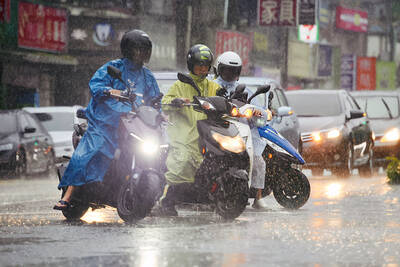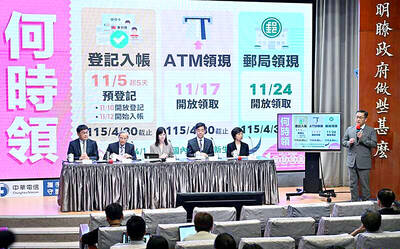The nation’s space development program is to receive an additional NT$40 billion (US$1.23 billion) in funding, President Tsai Ing-wen (蔡英文) said yesterday in a speech at the opening of the Taiwan International Assembly of Space Science, Technology and Industry in Taipei.
The launch of Taiwan’s first domestically produced weather satellite, Triton, earlier this month proves that the nation not only has advantages in semiconductors and precision manufacturing, but also the ability to enter the global space industry, Tsai said.
The additional funding for the third phase of the space development program — initiated in 2019 with an investment of NT$25.1 billion over 10 years — would go into supporting the development of low Earth orbit communication satellites, as well as national launch sites for satellites, she said.

Photo: Fang Pin-chao, Taipei Times
In a keynote speech, US Assistant Secretary of Commerce for Environmental Observation and Prediction Michael Morgan highlighted cooperative space projects that have brought together Taiwanese scientists and US engineers.
For example, the launch of Taiwan’s Formosat-7/COSMIC-2 satellites in 2019 was the largest science technology activity undertaken by Taiwanese and US authorities, Morgan said.
“We have seen that the data from this mission are critical in the operations of NOAA’s [the US National Oceanic and Atmospheric Administration] weather service,” he said.
The satellites reduced errors in global modeling data from NOAA by about 6 percent, he said.
The US Air Force’s 557th Weather Wing also uses this important data, he added.
The NOAA and the Center for Space and Remote Sensing Research at National Central University in Taoyuan are also collaborating on space-based marine oil pollution and marine debris monitoring, he said.
Taiwan’s Triton, also known as the Wind-Hunter Satellite, has potential for retrieving wind data, and assessing soil moisture and flood inundation, he added.
The near-surface wind retrievals are particularly valuable, providing crucial insights into understanding the structure of cyclones over oceans, he said.
“We have identified mutually beneficial collaboration on space weather through the accommodation of space weather instruments on the upcoming TASA [Taiwan Space Agency] and Formosat-8 spacecraft missions,” he said, referring to TASA’s ongoing development of six high-resolution optical satellites, known collectively as the Formosat-8 satellite constellation.
The five-day conference, the largest international showcase for Taiwan’s space industry, brings together public and private sector operators in space technology from countries including India, Japan and the US.
TASA, which hosts the annual conference, says the event serves as a platform for integrating the fields of science, technology and industry in the sector, to attract international attention to Taiwan’s space development and facilitate cooperation.
The conference includes forums, keynote speeches, academic presentations and exhibition booths where satellite and communication industry representatives display their latest developments.

The combined effect of the monsoon, the outer rim of Typhoon Fengshen and a low-pressure system is expected to bring significant rainfall this week to various parts of the nation, the Central Weather Administration (CWA) said. The heaviest rain is expected to occur today and tomorrow, with torrential rain expected in Keelung’s north coast, Yilan and the mountainous regions of Taipei and New Taipei City, the CWA said. Rivers could rise rapidly, and residents should stay away from riverbanks and avoid going to the mountains or engaging in water activities, it said. Scattered showers are expected today in central and

People can preregister to receive their NT$10,000 (US$325) cash distributed from the central government on Nov. 5 after President William Lai (賴清德) yesterday signed the Special Budget for Strengthening Economic, Social and National Security Resilience, the Executive Yuan told a news conference last night. The special budget, passed by the Legislative Yuan on Friday last week with a cash handout budget of NT$236 billion, was officially submitted to the Executive Yuan and the Presidential Office yesterday afternoon. People can register through the official Web site at https://10000.gov.tw to have the funds deposited into their bank accounts, withdraw the funds at automated teller

COOPERATION: Taiwan is aligning closely with US strategic objectives on various matters, including China’s rare earths restrictions, the Ministry of Foreign Affairs said Taiwan could deal with China’s tightened export controls on rare earth metals by turning to “urban mining,” a researcher said yesterday. Rare earth metals, which are used in semiconductors and other electronic components, could be recovered from industrial or electronic waste to reduce reliance on imports, National Cheng Kung University Department of Resources Engineering professor Lee Cheng-han (李政翰) said. Despite their name, rare earth elements are not actually rare — their abundance in the Earth’s crust is relatively high, but they are dispersed, making extraction and refining energy-intensive and environmentally damaging, he said, adding that many countries have opted to

PEACE AND STABILITY: Maintaining the cross-strait ‘status quo’ has long been the government’s position, the Ministry of Foreign Affairs said Taiwan is committed to maintaining the cross-strait “status quo” and seeks no escalation of tensions, the Ministry of Foreign Affairs (MOFA) said yesterday, rebutting a Time magazine opinion piece that described President William Lai (賴清德) as a “reckless leader.” The article, titled “The US Must Beware of Taiwan’s Reckless Leader,” was written by Lyle Goldstein, director of the Asia Program at the Washington-based Defense Priorities think tank. Goldstein wrote that Taiwan is “the world’s most dangerous flashpoint” amid ongoing conflicts in the Middle East and Russia’s invasion of Ukraine. He said that the situation in the Taiwan Strait has become less stable